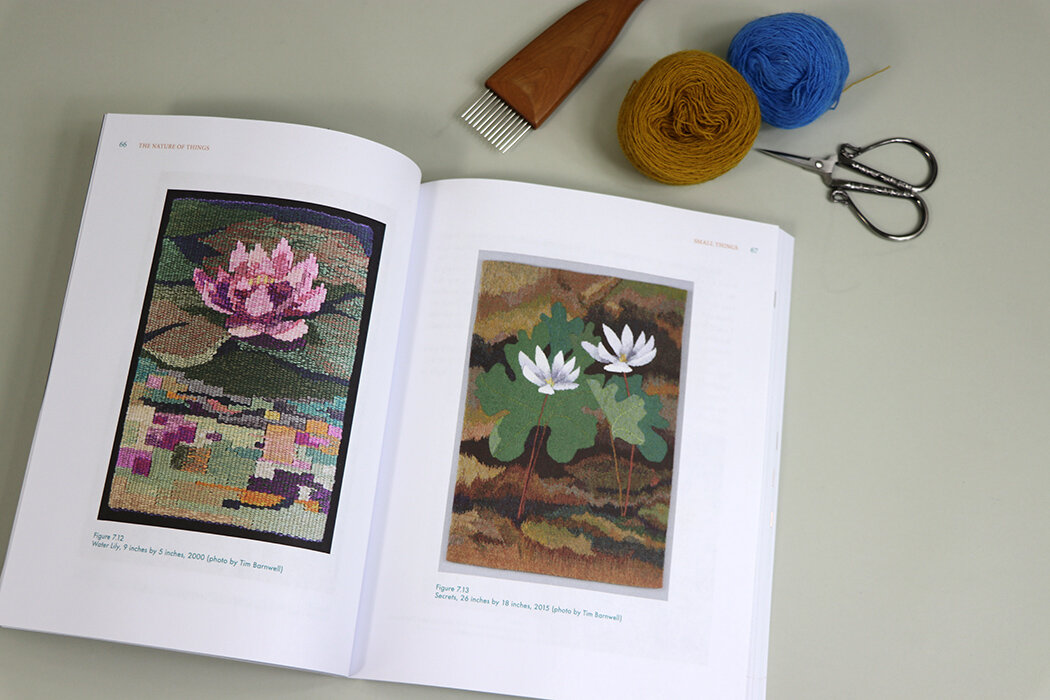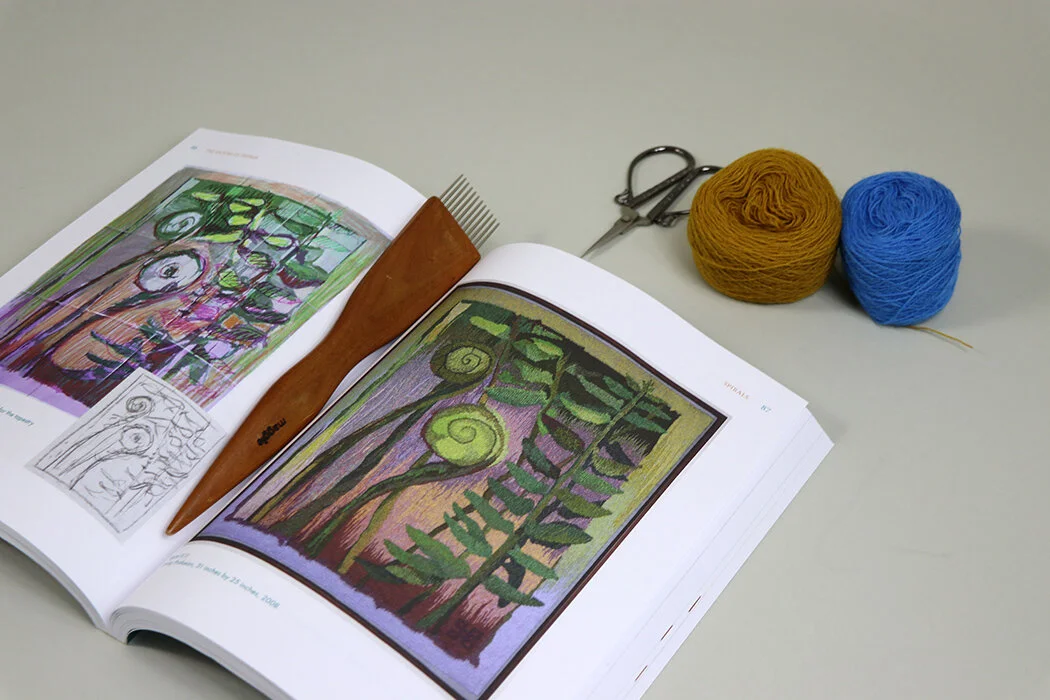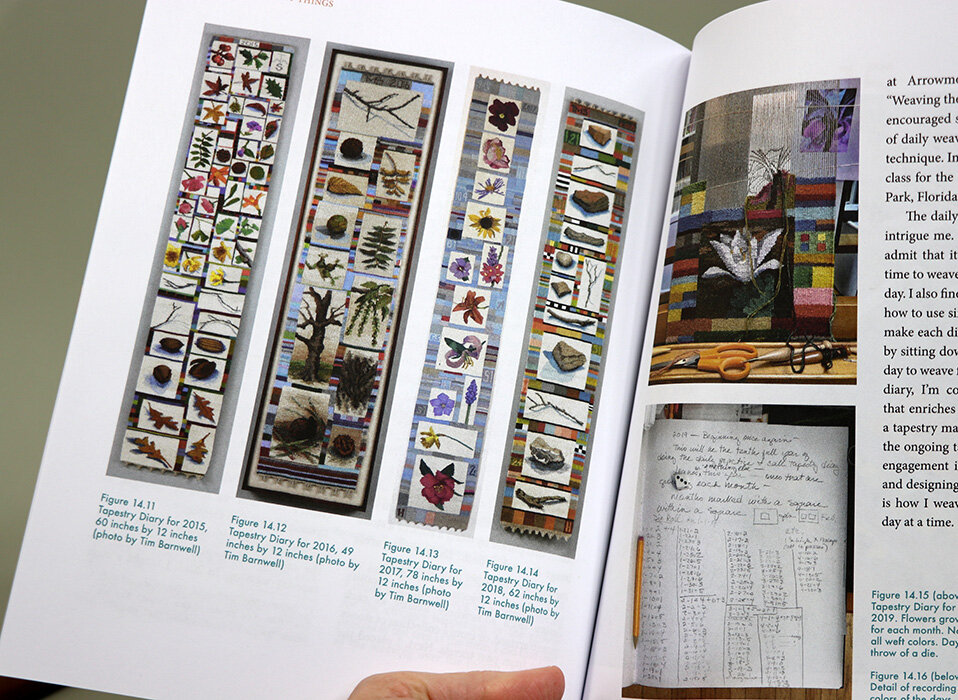Tommye McClure Scanlin is an artist from North Georgia. But I might also say that she is of North Georgia. She is an artist that is firmly rooted in this place she has lived all of her life and this is the thread I feel running through her artwork. Her new book, The Nature of Things: Essays of a Tapestry Weaver, has just been released from University of North Georgia Press.
The Nature of Things by Tommye Scanlin.
“A few years ago as I was preparing a presentation about my work, it occurred to me that my primary source of inspiration has always been found in the world in which I grew up—the fields and valleys of the Southern Appalachian Mountains…. Every day, I still find something to see and wonder about and to respond to in a visual way, maybe in a photograph, a sketch, a painting, or a tapestry. There is beauty in the limits of place and time. Maybe Dorothy from The Wizard of Oz said it best: “There’s no place like home.” And so I wanted to write to describe the small things that I’ve found where I’ve lived for almost my whole life and the artworks that came from those observations.”
How the book is set up
The book is paperback, perfect bound. It has a wide-paged format which lends itself to Tommye’s tapestry images. The images are clear and the colors fairly true to the tapestries of hers I’ve seen in person. The chapters are mostly organized around the subject matter of her work. This allows us to follow the story of an idea from inception to finished tapestries, whether those works were created sequentially or years apart. It is an image-heavy book with many illustrations showing us her process including inspiration, design methods, and the weaving. This “showing” is also a powerful teaching method and Scanlin seems to be encouraging us throughout the book to see and then to make.
The appendices include an extremely concise summary of how to weave tapestry, galvanized pipe loom plans, a glossary of tapestry terms, and a resource guide. Tommye is an outstanding educator and the 20 pages she devotes to giving the reader the basics of how to weave tapestry are some of the best instructions in the shortest span of pages I’ve ever seen.
The book is full of what might, in another context, be construed as advice or tips, but Tommye gives us these ideas just through her storytelling. She speaks about where she finds inspiration (artwork, nature, color, form, poetry, events, and through doing), talks about how she observes and records her observations, and she underlines her belief that creativity comes from hard work. And so through her stories, we can understand what each of us might do to follow our own artistic journeys.
The book includes some content derived from personal struggles, and Tommye’s courage in telling the reader where the work came from in her personal life makes for a powerful reading experience. She doesn’t shy away from telling us about her own doubts in her work over the decades and this last chapter left me with a hopeful feeling, because if an artist and educator like Tommye has doubts, then it must not just be me. We all do.
More on the content
In my personal experience with Tommye through our friendship, her mentorship of my skills over the last decade, reading her blog, and as fellow teachers of tapestry weavers, it has been impossible not to notice how dedicated Tommye is to her students. Though I have never had the privilege of taking a workshop or course with her, I’ve seen her preparation for these courses and heard from students who have been in those rooms. Her process is one of exploration which includes a dedication to asking herself questions every time she teaches a workshop and most often includes new woven samples as she considers how best to encourage her students to find their own path.
That dedication to exploration is one of the narrative strands throughout The Nature of Things. Because developing her own designs and work is full of this nature of exploration: from her walks in the woods as she contemplates subject matter through various methods of designing including painting, drawing, dyeing, collage, and woven sampling. Seeing this process laid out repeatedly in this book as she takes us through her work in various series and about a variety of subjects, underlines the organic way she works. She pays attention to what interested her in a particular project and she works through that interest in another iteration. Hearing her talk about this and seeing the images she provides of a project as it evolves is a powerful way to communicate her artistic process and draw us into her work.
Near the end of the book, she talks about her tapestry diary process and some thoughts about time. She has done a tapestry diary where she weaves at least a small bit every day for over ten years now. She says, “by sitting down at the loom each and every day to weave for a short time on the tapestry diary, I’m continuing a ritual of practice that enriches the discipline necessary to be a tapestry maker. The daily commitment to the ongoing tapestry diaries—as well as my engagement in looking at, thinking about, and designing from the world around me—is how I weave the threads of my life, one day at a time.” (page 177)
“The process of first digging for ideas and then developing them further in creative ways may be painful or joyful or even sometimes boring—but always must take the form of action. Writers often say: “You have to show up every day…” and I’ve found that to be true in my visual work. I have to make the effort to discover the potential that lies in assorted ideas and images I generate every day. Every darn day.”
Summary
Tommye Scanlin has been a personal friend and mentor to me over the last decade and so I have to consider that my reaction to this book might be biased because of what I know about Tommye personally. But upon revisiting my thoughts and looking over the book a second time, I don’t think this is the case. This book is a wonderful heart-felt summary of an artist’s journey in woven tapestry. It isn’t a biography, though there are many biographical sketches in it which relate to the subject matter of the artist’s work. It is primarily a series of essays about her major bodies of work, the way she works, and her dedication to working fully and consistency to the best of her ability every day. The images of her sketches, paintings, and the final tapestries attest to her unwavering and constant work in tapestry over the last 30 years of her art career.*
This book is an honest look at the life of an artist and an encouraging reminder to emerging artists that there are always struggles and that the process of making art is far from linear. Tommye assures us that the process and the outcome are worth the effort.
Tommye has a second book which will be released in the spring of 2021 by Schiffer Publishing entitled Tapestry Design Basics and Beyond: Planning and Weaving with Confidence.** I believe that the combination of these two books which she wrote parts of concurrently, will be a powerful testament to creating art in the medium of hand-woven tapestry. I recommend reading The Nature of Things now and putting Tapestry Design Basics and Beyond on your wishlist for next year. You won’t be sorry.
“As I roam through the woods, I wonder how I might possibly represent some of the beauty I’m observing. I know the images I’m capable of making will only dimly represent what I see and feel. I realize that noticing is the first step of many I’ll take on the way from a fleeting observation to finished tapestry. Many hours of making and refining images are ahead of me as I attempt to create a tapestry that will contain an essence of the place, the time, and my feelings of the experience, brief though it may have been.”
You can find out more about Tommye McClure Scanlin and her work on her website and blog.
website: https://www.scanlintapestry.com/
The gallery below gives you a better idea of how the book is laid out. Click on the thumbnails to enlarge, hover for captions, arrows to scroll.
*Previously she was a high school art teacher and then university art professor, a career that overlapped with her work as a tapestry artist and educator.
** In the spirit of full disclosure, I did write the foreword to Tapestry Design Basics and Beyond.






